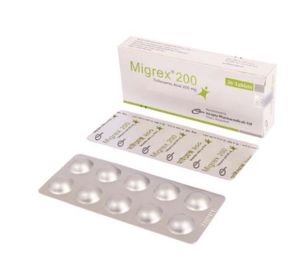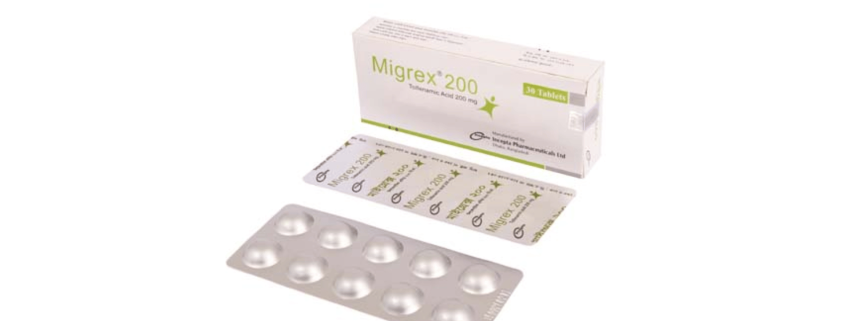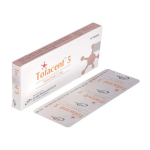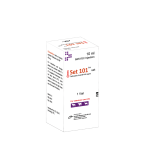Migrex(Tolfenamic acid )

Therapeutic Group: Drugs of Nervous System
Presentation
Migrex 200 mg tablet: Each tablet contains Tolfenamic acid BP 200 mg.
Description
Tolfenamic acid (N-(2-methyl-3-chlorophenyl) anthranilic acid) belongs to the fenamate group and is a potent inhibitor of cyclo-oxygenase enzyme, thus inhibits the synthesis of important inflammatory mediators such as thromboxane (Tx) B2 and prostaglandin (PG) E2. Prostaglandins are responsible for causing swelling, pain and inflammation associated with these conditions. It acts not only by inhibiting prostaglandin synthesis, but it also has a direct antagonistic action on its receptors.
Pharmacokinetic properties
Absorption: Readily absorbed from GI tract. Peak plasma concentration: 60-90 min. Bioavailability: 85%. Distribution: Protein-binding: 99%. Plasma half-life: 2 hr. Distributed into breast milk. Metabolism: Metabolised in the liver. Tolfenamic acid undergoes enterohepatic circulation.
Excretion: Excreted in urine (90%) and faeces.
Indications
Migrex is used specifically for relieving the pain of migraine headaches and also recommended for use as an analgesic in post-operative pain, and fever.
Dosage & Administration
Acute migraine attacks
Adult: 200 mg when 1st symptoms appear may be repeated once after 1-2 hr. Renal impairment: Dose adjustments may be needed. Severe: Avoid.
Mild to moderate pain
Children: A paediatric dosage regimen has not yet been established. Adult: 100-200 mg tid.
Renal impairment: Dose adjustments may be needed. Severe: Avoid. It should be taken with food. Take water/ or immediately after meals.
Preclinical safety data
The therapeutic index for Migrex is high, and gastrointestinal ulceration and kidney changes have only been seen with oral doses approximately 6-10 times the maximum therapeutic dose recommended for tolfenamic acid.
Special Precautions
Asthma, bronchospasm, bleeding disorders, cardiovascular diseases, history of peptic ulceration, hypertension, patients with infections, liver, cardiac, or renal function impairment. Increase water intake or dose reduction to reduce dysuria. CHF; elderly; lactation.
Side Effects
Dysuria especially in males; diarrhoea, nausea, epigastric pain, vomiting, dyspepsia, erythema, headache. Tremor, euphoria, fatigue, pulmonary infiltration, & haematuria. Potentially Fatal: Blood dyscrasias, toxic hepatitis.
Precautions
N/A
Use in Pregnancy & Lactation
Pregnancy: This medicine is not recommended for use during pregnancy unless considered essential by your doctor. This is particularly important in the first and third trimesters. Not to be given during the third trimester of pregnancy. Lactation: In limited studies so far available, NSAIDs can appear in breast milk in very low concentrations. NSAIDs should, if possible, be avoided when breastfeeding.
Drug Interaction
The rate of absorption of Migrex increases with metoclopramide and magnesium hydroxide and decreases with aluminium hydroxide. Risk of bleeding with anticoagulants and other NSAIDs increases when use with Migrex. It decreases antihypertensive response to loop diuretics, β-blockers and ACE inhibitors. Co-administration increases plasma concentrations of lithium, methotrexate and cardiac glycosides. It also increases the risk of nephrotoxicity with ACE inhibitors, ciclosporin, tacrolimus or diuretics.
Over Dose
Symptoms include headache, nausea, vomiting, epigastric pain, gastrointestinal bleeding, diarrhoea, excitation, coma, drowsiness, dizziness, tinnitus, fainting, and convulsions. In cases of significant poisoning acute renal failure and liver damage are possible. Patients should be treated symptomatically as required.
Storage
Store in a cool, dry place, and away from direct heat and light. Keep out of the reach of children.
Commercial Pack
Migrex 200: Each box contains 30 tablets



